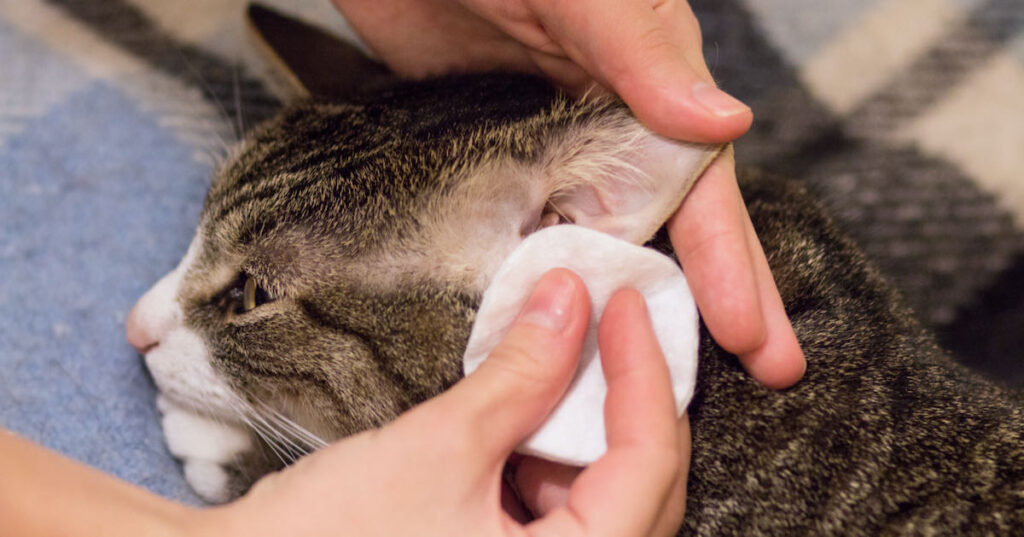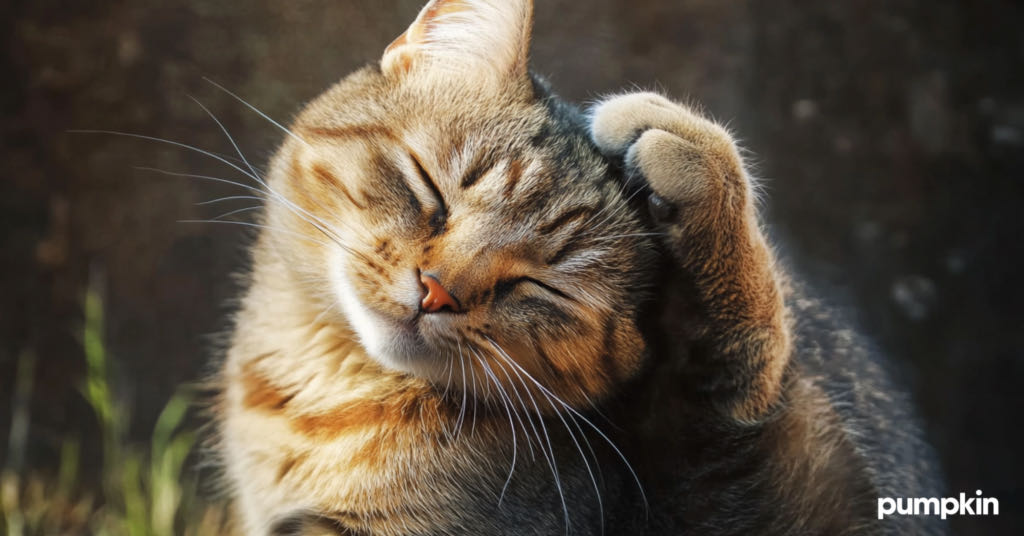Key Points
- If your cat is scratching their ears frequently, and if they have red or inflamed ears, they may have ear mites.
- Mites are highly contagious, so your cat can get them by simply being too close to another infected animal.
- Routine cleaning of your cat’s ears can help prevent an ear mite infestation and other ear problems.
Have you noticed your cat angling their head and scratching their ears? Or are they suddenly shaking their head? How about a mysterious ear discharge that looks like coffee grounds? These are all tell-tale signs of ear mites in cats, a common parasitic infection.
Ear mites (also known as Otodectes cynotis) look like small white dots that can barely be seen by the naked eye. Although they can’t hop or fly, these tricky little parasites can crawl from one cat to another and even travel to other body parts besides the ears.
If these nearly microscopic bugs set up shop in your cat’s ear canal, they will make your kitty very uncomfortable. You can keep your kitty bug-free by understanding the causes and symptoms of ear mites and learning how to get rid of them.
What causes ear mites in cats?
Due to their highly contagious nature, cats can get ear mites by simply being too close to another infected animal. “Ear mites can spread from one cat to another, especially if they spend a lot of time together,” says Dr. Sara Ochoa (DVM), a veterinarian with Cat World. “If one cat in your house has been diagnosed with ear mites, it’s best to check all your cats,” she advises.

Ear mites can also travel between parent cats and newborn kittens, and between animals of different species. Although ear mites can occur in cats of any age, they’re typically more common in kittens and outdoor cats, as well as cats that have spent time in shelters. “Most adult cats that live strictly indoors have never had ear mites,” Dr. Ochoa says. “Even adult cats that live outside rarely have ear mites, unless they have come into contact with kittens.”
Symptoms of ear mites in cats
The good news is that it’s not hard to notice the symptoms of ear mites in cats. For example, you may see your cat continuously shaking their head, or keeping their head tilted at an angle. They may be trying to remove the tiny parasites themselves by angling their head and scratching at their ear.
As the mites burrow into the ear canal, your cat will display the following symptoms:
- Frequent head shaking and scratching around their ear, head, and neck
- Red and inflamed ears caused by irritation
- Dry, crumbly, dark ear discharge or wax in or around the ear canal
- Stinky odor coming from the inside of the ear canal
How to check for ear mites in cats
Ear mites are about the size of a pinhead or a grain of salt, so it’s hard to see them, but you’ll be able to see the crusty ear discharge sitting in your cat’s ear canal. It may resemble dirt or coffee grounds since it’s a mixture of waxy discharge, blood, and secretions from the mites.
If ear mites have spread to other parts of your cat’s body, you may notice them scratching in those areas as well. Your kitty will also have crusted skin and scaling on their neck, rear, and tail. In severe cases, you may even notice balding in the affected area caused by excessive scratching.
When in doubt, compare pictures of ear mites in cats to your own kitty’s ear.

What to do if your cat has ear mites
Okay, so your cat has ear mites — what now? First, you should schedule an appointment with your vet. Aside from relieving your cat’s discomfort, an ear checkup can help curb other infections that may be brewing. If left untreated, this parasitic infection can lead to more severe skin or ear infections for your cat, making a bad situation worse.
Treatment for ear mites
To confirm a diagnosis of ear mites, your vet will look for mites through an otoscope, a magnifying glass for the ears. They may also swab your cat’s ear to retrieve a sample they can look at under a microscope. If the parasites are found, your vet will prescribe the necessary medication.
Treatment usually starts with a deep cleaning of your cat’s ears to remove any wax or dirt that may prevent the medication from penetrating the ears.
FDA-approved treatments for ear mites include topical and oral medications. These treatments target both adult ear mites and the eggs.
While you can find over-the-counter treatments, we recommend talking to your vet before buying any of these medications.
Recovery and care
Remember: Nothing kills ear mites in cats instantly, so be skeptical of any OTC treatments making big promises like that. It can take up to three weeks after treatment begins to fully eliminate ear mites, but most cats feel back to normal in about 10 days. During this time, your cat’s itchiness and discomfort should subside as the medication takes effect. Your vet may want to re-examine your cat to ensure the mites are gone and rule out any possibility of a secondary infestation.
It’s important to let your veterinarian know if there are any other household pets in your home, to reduce the chances of exposure.
How to prevent ear mites in cats
Although cats are meticulous groomers, they can’t reach the inside of their ears. For this reason, one of the best ways to protect your cat against ear mites is by scheduling regular veterinary check-ups and performing at-home ear cleanings.
You can also apply preventive medications directly to your cat’s skin to protect them from tiny parasites. This is the method Dr. Ochoa recommends: “Most products can be applied to your cat each month to help prevent them from getting ear mites,” she says. “Also, making sure that your cat’s ears are clean and free of dirt and debris can help.”

If left untreated, ear mites can cause your cat serious pain and discomfort. So, if you suspect mites have taken up residence, don’t play it by ear — talk to your vet.
Pet parenthood is full of surprises, both the good and the not-so-good. Pet insurance can help cat owners take the bite out of unexpected vet bills. Learn more about how Pumpkin Cat Insurance plans can help cover eligible vet bills in the future to keep your kitty — and your wallet — healthy.




